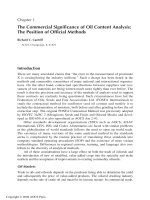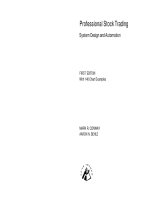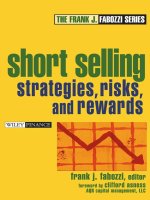Short Selling Strategies, Risks, and Rewards phần 1 pps
Bạn đang xem bản rút gọn của tài liệu. Xem và tải ngay bản đầy đủ của tài liệu tại đây (660.22 KB, 44 trang )
Short
Selling
Strategies, Risks, and Rewards
FRANK J. FABOZZI
EDITOR
John Wiley & Sons, Inc.
ffirs.frm Page iii Thursday, August 5, 2004 10:42 AM
Sect1 Page 8 Thursday, August 5, 2004 10:45 AM
Short
Selling
ffirs.frm Page i Thursday, August 5, 2004 10:42 AM
THE FRANK J. FABOZZI SERIES
Fixed Income Securities, Second Edition by Frank J. Fabozzi
Focus on Value: A Corporate and Investor Guide to Wealth Creation by James L.
Grant and James A. Abate
Handbook of Global Fixed Income Calculations by Dragomir Krgin
Managing a Corporate Bond Portfolio by Leland E. Crabbe and Frank J. Fabozzi
Real Options and Option-Embedded Securities by William T. Moore
Capital Budgeting: Theory and Practice by Pamela P. Peterson and Frank J. Fabozzi
The Exchange-Traded Funds Manual by Gary L. Gastineau
Professional Perspectives on Fixed Income Portfolio Management, Volume 3 edited
by Frank J. Fabozzi
Investing in Emerging Fixed Income Markets edited by Frank J. Fabozzi and
Efstathia Pilarinu
Handbook of Alternative Assets by Mark J. P. Anson
The Exchange-Traded Funds Manual by Gary L. Gastineau
The Global Money Markets by Frank J. Fabozzi, Steven V. Mann, and
Moorad Choudhry
The Handbook of Financial Instruments edited by Frank J. Fabozzi
Collateralized Debt Obligations: Structures and Analysis by Laurie S. Goodman
and Frank J. Fabozzi
Interest Rate, Term Structure, and Valuation Modeling edited by Frank J. Fabozzi
Investment Performance Measurement by Bruce J. Feibel
The Handbook of Equity Style Management edited by T. Daniel Coggin and
Frank J. Fabozzi
The Theory and Practice of Investment Management edited by Frank J. Fabozzi and
Harry M. Markowitz
Foundations of Economic Value Added: Second Edition by James L. Grant
Financial Management and Analysis: Second Edition by Frank J. Fabozzi and
Pamela P. Peterson
Measuring and Controlling Interest Rate and Credit Risk: Second Edition by
Frank J. Fabozzi, Steven V. Mann, and Moorad Choudhry
Professional Perspectives on Fixed Income Portfolio Management, Volume 4 edited
by Frank J. Fabozzi
The Handbook of European Fixed Income Securities
edited by Frank J. Fabozzi
and Moorad Choudhry
The Handbook of European Structured Financial Products edited by Frank J.
Fabozzi and Moorad Choudhry
The Mathematics of Financial Modeling and Investment Management by Sergio M.
Focardi and Frank J. Fabozzi
ffirs.frm Page ii Thursday, August 5, 2004 10:42 AM
Short
Selling
Strategies, Risks, and Rewards
FRANK J. FABOZZI
EDITOR
John Wiley & Sons, Inc.
ffirs.frm Page iii Thursday, August 5, 2004 10:42 AM
Copyright © 2004 by John Wiley & Sons, Inc. All rights reserved.
Published by John Wiley & Sons, Inc., Hoboken, New Jersey
Published simultaneously in Canada
No part of this publication may be reproduced, stored in a retrieval system, or transmitted in
any form or by any means, electronic, mechanical, photocopying, recording, scanning, or oth-
erwise, except as permitted under Section 107 or 108 of the 1976 United States Copyright
Act, without either the prior written permission of the Publisher, or authorization through
payment of the appropriate per-copy fee to the Copyright Clearance Center, Inc., 222 Rose-
wood Drive, Danvers, MA 01923, 978-750-8400, fax 978-646-8600, or on the web at
www.copyright.com. Requests to the Publisher for permission should be addressed to the Per-
missions Department, John Wiley & Sons, Inc., 111 River Street, Hoboken, NJ 07030, 201-
748-6011, fax 201-748-6008.
Limit of Liability/Disclaimer of Warranty: While the publisher and author have used their best
efforts in preparing this book, they make no representations or warranties with respect to the
accuracy or completeness of the contents of this book and specifically disclaim any implied
warranties of merchantability or fitness for a particular purpose. No warranty may be created
or extended by sales representatives or written sales materials. The advice and strategies con-
tained herein may not be suitable for your situation. You should consult with a professional
where appropriate. Neither the publisher nor author shall be liable for any loss of profit or
any other commercial damages, including but not limited to special, incidental, consequential,
or other damages.
For general information on our other products and services, or technical support, please con-
tact our Customer Care Department within the United States at 800-762-2974, outside the
United States at 317-572-3993, or fax 317-572-4002.
Wiley also publishes its books in a variety of electronic formats. Some content that appears in
print may not be available in electronic books.
For more information about Wiley, visit our web site at www.wiley.com.
ISBN: 0-471-66020-5
Printed in the United States of America
10 9 8 7 6 5 4 3 2 1
ffirs.frm Page iv Thursday, August 5, 2004 10:42 AM
v
Contents
Foreword ix
Clifford S. Asness
Preface xiv
About the Editor xv
Contributing Authors xvi
CHAPTER 1
Introduction 1
Frank J. Fabozzi, Steven L. Jones, and Glen Larsen
SECTION ONE
The Mechanics of Short Selling 7
CHAPTER 2
Mechanics of the Equity Lending Market 9
Jeff Cohen, David Haushalter, and Adam V. Reed
The Lending Process 10
Lenders 11
Borrowers 13
The Determinants of Rebate Rates 15
Conclusion 16
CHAPTER 3
Shorting Using Futures and Options 17
Frank J. Fabozzi
Futures Contracts 17
Equity Options 30
Summary 36
ftoc.frm Page v Thursday, August 5, 2004 10:40 AM
vi Contents
CHAPTER 4
Is Selling ETFs Short a Financial “Extreme Sport”? 37
Gary L. Gastineau
What Are the Most Important Safety Features
Protecting ETF Short Sellers? 38
How Do ETFs Work in Risk Management Applications? 39
Who Owns ETF Shares? 43
Will It Always Be Possible to Borrow ETF Shares at
Low-Cost for Risk Management Applications? 47
What Is the Effect of Short Selling and Risk Management
Activity on ETF Trading Volume and Trading Costs? 49
Are Risk Management Applications and Heavy ETF Share Trading
Desirable for Fund Shareholders and Fund Advisors? 51
What Is the Significance of the Short Interest for
Growth in ETF Assets? 52
Conclusion 56
SECTION TWO
Theory and Evidence on Short Selling 59
CHAPTER 5
Restrictions on Short Selling and Exploitable Opportunities for Investors 61
Edward M. Miller
Demand and Supply Curves Arguments 62
The Pattern of Stock Prices Over Time with
Uninformed Investors 75
The Bounded Efficient Markets Hypothesis 91
Conclusions 114
CHAPTER 6
Implications of Short Selling and Divergence of Opinion for Investment Strategy 117
Edward M. Miller
Interaction of Divergence of Opinion and Short Selling Restrictions 119
Empirical Tests 134
Conclusions 176
CHAPTER 7
Short Sale Constraints and Overpricing 179
Owen A. Lamont
Short Sale Constraints 180
The Overpricing Hypothesis 184
Costs of Shorting 188
Go Down Fighting 191
3Com/Palm 193
Tech Stock Mania and Short Sale Constraints 200
Summary 203
ftoc.frm Page vi Thursday, August 5, 2004 10:40 AM
Contents vii
CHAPTER 8
How Short Selling Expands the Investment Opportunity Set and
Improves Upon Potential Portfolio Efficiency 205
Steven L. Jones and Glen Larsen
Short Selling in Efficient Portfolios: The Theory and
Its Practical Implications 207
The Empirical Evidence on Short Positions in Ex Post
Efficient Portfolios 229
Concluding Remarks and Practical Implications for Investors 231
CHAPTER 9
The Information Content of Short Sales 233
Steven L. Jones and Glen Larsen
Short Sales: Reporting, Frequency, and Constraints 235
Academic Theory versus the Technical Analyst’s View 236
The Empirical Evidence 239
Conclusions and Implications for Investors 253
SECTION THREE
Short Selling Strategies 257
CHAPTER 10
Spotting Clues in Qs 259
Ron Gutfleish and Lee Atzil
Looking for the Easier Fight 260
Putting on the Green Eyeshades 261
So What? It’s Only Accounting 265
How Do You Find these Cases? 266
Diagnosis 270
Keeping Your Shorts On 270
Tales from the Front Lines: Three Examples 271
Summary 278
CHAPTER 11
The Economic Profit Approach to Short Selling 279
James A. Abate and James L. Grant
Short Selling in the Theory of Finance 280
Tenets of Good and Bad Companies 280
Positive NPV: Discovery of Good Companies 281
Negative NPV: Discovery of Bad Companies 284
Zero NPV: Wealth Neutral Companies 287
Case Studies 287
Role of the Value/Capital Ratio 291
Invested Capital Growth 292
Managerial and Investor Implications 294
ftoc.frm Page vii Thursday, August 5, 2004 10:40 AM
viii Contents
Matrix of Good and Bad Companies 295
Reconciling Market Implied Growth 298
Summary 301
CHAPTER 12
Long-Short Equity Portfolios 303
Bruce I. Jacobs and Kenneth N. Levy
Constructing a Market Neutral Portfolio 304
The Importance of Integrated Optimization 308
Adding Back a Market Return 312
Some Concerns Addressed 316
Evaluating Long-Short 318
SECTION FOUR
Short Selling and Market Efficiency 321
CHAPTER 13
Short Sales in Global Perspective 323
Arturo Bris, William N. Goetzmann, and Ning Zhu
Short Sales Restrictions Around the World 325
Foreign Listing and Short Selling 331
Short Selling Constraints and International Capital Flows 339
Conclusion 342
CHAPTER 14
Short Selling and Financial Puzzles 345
Edward M. Miller
Divergence of Opinion and Risk 346
Returns to Beta 355
Implications for Value Additivity 374
Conclusions 393
INDEX 395
ftoc.frm Page viii Thursday, August 5, 2004 10:40 AM
ix
Foreword
Short selling is un-American. It is done by rogues, thieves, and especially
pessimists, who are, of course, the worst of the lot. It is a terrible, terrible
thing and must be stopped in our lifetime. We should halt it, restrict it, or
at the very least revile those who make it their vocation.
The above sentiments are sadly not imaginary or rare. Rather, they
genuinely reflect much of the investing public’s view of short selling. In
fact, attacks have included proposals to make short selling harder (the
existing “uptick rule” already makes it hard), or to make it impossible by
banning it outright (presumably along with pessimism itself, and perhaps
the infield fly rule). These criticisms and draconian proposals all increase
in volume and seriousness when the stock market goes through a tough
time. At such times many claim short sellers are the cause of the market’s
decline. Finally, at the low point for stock prices, many members of Con-
gress invariably reexamine whether shorting should be allowed, or more
simply, consider just legislating that the Dow go up 50 points a day.
Of course, the media does not help. A rising stock market is a good
thing for ratings and circulation. This country is, of course, biased
toward rooting for stocks to go up, and people watch and read more
about this stuff when it is fun (i.e., going up). Thus, short sellers, with
their gloomy attitude, are not generally media friendly. In fact, even
some pro-free enterprise media outlets sometimes throw away their lais-
sez faire stance when it comes to short selling, particularly “in times of
crisis” (defined as an overvalued market getting a bit less overvalued).
Apparently, they have some confusion regarding the difference between
supporting a free capital market versus supporting an expensive one.
Well, to sum up the theme of this foreword, opponents of short sell-
ing are not merely wrong. They are incredibly wrong, both factually and
morally. Short sellers are among the heroes of capitalism and we owe
them our thanks not our opprobrium. The opponents of short selling
are either exceptionally economically challenged, or run to a natural
tendency to ban anything they do not like. There’s a word for the politi-
cal system favored by people like that and it is not democracy (but does
rhyme with Motalitarianism).
fbetw.frm Page ix Thursday, August 5, 2004 10:42 AM
x Foreword
Extensive theory may be helpful, but it is not necessary, to under-
stand why the ability to implement a pessimistic view (e.g., to sell short)
improves market efficiency and thus makes the market safer for all par-
ticipants. Without short selling, prices are in a sense uncapped. As valu-
ations get excessive the only way to express a negative view is to go on a
buying strike. It is analogous to a voter who disliked the incumbent, but
found the only option was to stay home, as voting for the challenger
was prohibited (again, we have seen systems like that in the world, but
we are just not supposed to have one here). It seems quite intuitive that
if we restrict the ability to express pessimistic views, prices will on net
be biased towards the optimistic outlook. Of course the goal of efficient
financial markets is to have prices reflect our collective best guess, some-
where between optimistic and pessimistic. It follows that overpriced
stocks and stock markets, including incredibly destructive bubbles, are
best fought by allowing all opinions to affect prices. For instance, the
recent market/tech bubble would in all likelihood have been less egre-
gious with fewer hurdles to short selling. To put it simply, widows and
orphans are on net protected, not damaged by short sellers. Of course,
for this all to be true, short sellers must, as most of them claim, be fol-
lowing rational strategies and not following the same wild momentum
strategies as others just on the short side.
Luckily, short sellers as a group, at least according to the reported
hedge-fund indices, do what they say they do. A simple study of their
returns makes it clear they are net short stocks.
1
If this seems less than
revelatory, consider that doing what you say you are going to do is not
1
Using the short selling index from CSFB/Tremont and returns on the S&P 500, and
value-growth stocks and small-large stocks (HML and SMB from Professor Ken
French’s website respec-
tively) run the following regression (all returns are either on long/short portfolios or
excess over cash) monthly from 1994–2003:
CSFB Short return
= intercept +
β
1
× S&P 500 +
β
2
× [value-growth] +
β
3
× [small-large]
Running this regression leads to t-statistics on the betas of –16.4 (S&P 500), +3.1
(value-growth), and –7.4 (small-large) with an adjusted R-squared of 76.7%. Next
add one additional term to capture a potentially changing market beta through time.
This is an “interaction” term representing this month’s S&P 500 times the S&P
500’s return over the prior year. If this comes in with a positive (negative) slope it
means that short sellers ran a higher (lower) market beta after rolling years that the
market went up. Its t-statistic is –2.65 (so short sellers get shorter after market rallies)
with the statistical significance of the other factors unchanged (though the value-
growth t-statistic falls to a still significant +2.09, perhaps as this dynamic beta cap-
tures part of the time pattern of value’s return).
fbetw.frm Page x Thursday, August 5, 2004 10:42 AM
Foreword xi
always a slam dunk in today’s capital markets. More novel, shorts are
biased to get shorter when the market has been strong, that is, in aggre-
gate they fight a market trend.
2
They are biased to short smaller than
average stocks and, perhaps most importantly, to short expensive
stocks. In a world that often feels dominated by momentum investing
and one-way market cheerleading, they are short. They get more short
when the market goes up and less when it falls. And, when it comes to
stock selection, they are most short the most expensive growth stocks.
While individual short sellers might differ, in aggregate, they are not
shorting distressed companies to drive them to doom with misleading
Internet chat. Rather, in aggregate, short sellers are the Praetorian
Guard of the financial markets. These activities logically, and in fact, lead
to a more stable market where bubbles (both in aggregate and in relative
value) are fought by the short sellers (though as 1999–2000 shows, not
necessarily fought enough), and not, like done by much of the rest of the
investing world, simply ridden until the eventual ugly denouement.
Why do they do it? Consider the hurdles short sellers face. Stocks, on
average, rise over time. This is both an empirical fact and a theoretically
mandated occurrence. The long-run equity risk premium is positive. Short
sellers swim against this tide, taking their capital and betting against
“stocks for the long run.” Second, short sellers bet against the idea that
markets are efficient. While some of the returns to short selling can be
construed as just picking up a value premium which may be rational,
clearly the shorts themselves believe they are taking the rational side in an
irrational world. Also, the specific stocks they short, tend to be ones pre-
vailing wisdom favors, nay adores, and in the early days of a short posi-
tion they are often laughed at (with the last laugh often forgotten).
Furthermore, the risks of shorting may be greater than other invest-
ments. Some used to laugh at the common observation, “Don’t short
because you can lose an infinite amount of money.” Then 1999 came
along and proved the “fools” uttering this statement were not so wrong.
Truth be told however, the infinite loss possibility argument is still a bit
silly, as a diversified portfolio of shorts is definitely amenable to risk
control. But, it would be disingenuous not to acknowledge that shorting
involves some risk control challenges beyond those of traditional long-
only management.
Finally, successfully utilizing short selling does not just involve pick-
ing stocks that will ultimately fall, but convincing your investors to stick
with you when you are too early, and your portfolio of shorts moves
from 2
× to 4
× overvalued. Short sellers, by definition, tend to lose when
2
Probably meaning their feelings about valuations dominate any effect from getting
“squeezed” which might lead to them moving to less short after strong markets.
fbetw.frm Page xi Thursday, August 5, 2004 10:42 AM
xii Foreword
most others are winning, and lose even more when this is happening in
the context of an irrational bubble (as they get much shorter in the most
overvalued names). In principle, this should be the most palatable time
for a rough patch, as diversification is half the point of a short or market
neutral investment. But, it just does not work out that way. When you
lose and others are mostly winning, you have to defend yourself from
the charge that you are foolish, that you have lost your edge, that what
used to work does not work anymore because it is a “new world,” or
put more eloquently, “You stink, let us out of our lockup please.”
So, why do they do it? Greed, in the best capitalistic sense, is of
course part of it. They believe enough in their skill at identifying the
overvalued, the frauds, and the scams, that over the long run they will
be more than compensated for the many hurdles they face. But, while
not completely fungible, many or most of the skills in successful short-
ing work on the long-only side as well, with none of the hurdles above.
So why do they choose short selling? Well, like many who excel in any
field, you will find the short sellers choose short selling partly because
they have no choice. When they see the public fooled into buying over-
valued nonsense, when they see fraud perpetrated without retribution,
and when they see hucksters lauded by a stock market dying to anoint
the next emperor without clothes, they have no choice but to fight. They
feel a personal affront at the overvalued going up day after day, and
bubble-vision covering it in breathless admiration. They feel they must
do something about it. Ultimately, the shorts are in it to make money,
but if they can do that while being right when everyone else is wrong
(and actually help right a wrong) more the better. People acting in their
own interest, but also making the world better. Kind of how capitalism
is supposed to work no?
That brings us to this book, which is something special. It is not a
coincidence that this book wasn’t published in late 2002/early 2003
when so many hastily scribed, rush-job books on shorting came out at
the nadir of a bear market. These works were light on the content, and
heavy on the “You too Can Get Rich by Shorting” sentiments, generally
including a couple of “if you had only shorted blank at blank price you
would have made blank by now.” This book is different. The quality of
the authors, a collection of learned and respected academics and practi-
tioners, speaks to that, as does the coverage, scope, and seriousness of
the topics. This is not about getting rich quickly. It is about how short-
ing works, what short sellers actually do, how shorts uncover the over-
valued and the true ponzi schemes, economically why short selling is
important, the true impediments to shorting, and a host of other sober,
vital, and often neglected topics. It is not just about the canonical short-
only manager uncovering fraud and overvaluation as implicitly
fbetw.frm Page xii Thursday, August 5, 2004 10:42 AM
Foreword xiii
described above, it is also a detailed description of how shorting can be
part of an overall optimal portfolio, and can be pursued in all different
forms with all different types of managers (a systematic market-neutral
manager, a generally long manager who uses shorts to reduce risk and
hopefully add alpha, or a truly dedicated short manger).
This book not only pulls together much of the scattered literature
on short selling, but also adds dramatically to our body of knowledge. It
is not a “get rich quickly by shorting” book. But, reading this book
might help you become a better investor, as I believe it has done for me.
And, if there is a better way than this to get rich slowly, or at least to
stay solvent by avoiding scams, it has yet to be discovered.
Clifford S. Asness
Managing and Founding Principal
AQR Capital Management, LLC
fbetw.frm Page xiii Thursday, August 5, 2004 10:42 AM
xiv
Preface
Short Selling: Strategies, Risks, and Rewards provides the most recent theory
and empirical evidence on the practice of short selling. The chapters in this
book, contributed by leading practitioners and academics, explain not just
the complex mechanics of short selling and the associated risks, but also
why some stocks can be expected to become overpriced, strategies for
exploiting overpricing, and how short selling can improve portfolio perfor-
mance and market efficiency. Each chapter contains information relevant to
both institutional and individual investors who are currently using or may
be contemplating using short selling as a part of their investment manage-
ment strategy.
I wish to express my deep gratitude to the contributors of this book.
A special thanks to Edward Miller who contributed three chapters cov-
ering the underlying theory on why markets become overpriced (theory
of divergence of opinion) and the implications for investment manage-
ment when there are restrictions on short selling.
This book could not have been completed without the assistance of
Steven Jones and Glen Larsen. In addition to their contribution of three
chapters to the book, they reviewed all chapters in the book, suggested the
organization of the chapters, and identified several contributors.
Robert Krail of AQR Capital provided helpful comments on selected
portions of the manuscript.
I am grateful to Clifford Asness for reading the page proofs and pro-
viding the foreword.
Frank J. Fabozzi
fpref.frm Page xiv Thursday, August 5, 2004 10:43 AM
xv
About the Editor
Frank J. Fabozzi, Ph.D., CFA, CPA is the Frederick Frank Adjunct Professor
of Finance in the School of Management at Yale University. Prior to
joining the Yale faculty, he was a Visiting Professor of Finance in the Sloan
School of Management at MIT. Frank is a Fellow of the International Cen-
ter for Finance at Yale University, the editor of the Journal of Portfolio
Management, a member of Princeton University’s Advisory Council for
the Department of Operations Research and Financial Engineering, and
a trustee of the BlackRock complex of closed-end funds and Guardian
Life sponsored open-end mutual funds. He has authored several books
in investment management and in 2002 was inducted into the Fixed
Income Analysts Society’s Hall of Fame. He earned a doctorate in econom-
ics from the City University of New York in 1972.
flast.frm Page xv Thursday, August 5, 2004 10:41 AM
xvi
Contributing Authors
James A. Abate GAM USA Inc.
Lee Atzil Elm Ridge Capital
Arturo Bris Yale School of Management
Jeff Cohen Susquehanna Intl Group, LLLP
Frank J. Fabozzi Yale School of Management
Gary L. Gastineau ETF Consultants LLC
William N. Goetzmann Yale School of Management
James L. Grant JLG Research
Ron Gutfleish Elm Ridge Capital
David Haushalter Susquehanna Intl Group, LLLP
Bruce I. Jacobs Jacobs Levy Equity Management
Steven L. Jones Indiana University, Kelley School of Business
— Indianapolis
Owen A. Lamont Yale School of Management and NBER
Glen Larsen Indiana University, Kelley School of Business
— Indianapolis
Kenneth N. Levy Jacobs Levy Equity Management
Edward M. Miller University of New Orleans
Adam V. Reed University of North Carolina at Chapel Hill
Ning Zhu University of California, Davis
flast.frm Page xvi Thursday, August 5, 2004 10:41 AM
CHAPTER
1
1
Introduction
Frank J. Fabozzi, Ph.D., CFA
Fredrick Frank Adjunct Professor of Finance
School of Management
Yale University
Steven L. Jones, Ph.D.
Associate Professor of Finance
Indiana University, Kelley School of Business — Indianapolis
Glen Larsen, Ph.D., CFA
Professor of Finance
Indiana University, Kelley School of Business — Indianapolis
elling a long position is the most obvious means of avoiding losses in
what is perceived to be an overpriced asset. Short selling, on the
other hand, offers a means not just to avoid losses but also to profit
from knowledge of overpricing. Although the opportunity to short sell
is not new, the surge in hedge funds, many of which used short selling to
profit in the bear market, has focused renewed attention on the subject.
In fact, many believe that the competition for alpha will force pension
funds to relax the “no-short” constraint on their active managers.
1
But
for many investors, short selling remains an obscure, even mysterious
subject, seemingly more akin to art than investment science.
1
See Bob Litterman, “The Active Risk Puzzle: Implications for the Asset Manage-
ment Industry,” The Active Alpha Investing Series (Goldman Sachs Asset Manage-
ment, March 2004).
S
1-Fabozzi/Jones/Larsen-Intro Page 1 Thursday, August 5, 2004 11:07 AM
2 SHORT SELLING: STRATEGIES, RISKS, AND REWARDS
This book reflects the most recent theory and empirical evidence on
the practice of short selling. The chapters that follow explain not just the
complex mechanics of short selling, but also why we might expect some
stocks to become overpriced, strategies for exploiting overpricing,
including the use of derivatives, and how short selling can improve port-
folio performance and market efficiency. Each chapter contains informa-
tion relevant to both institutional and individual investors who are
currently using or may be contemplating the use of short selling as a part
of their investment management strategy. Special emphasis is placed on
the risks associated with short selling. For example, short selling is gen-
erally viewed as more risky than long investing because prices can always
go higher, which implies unlimited losses for a short position.
This book is divided into four sections. Section One covers the
mechanics of short selling. The mechanics are relatively complex com-
pared to a normal buy transaction. In Chapter 2, Jeff Cohen, David
Haushalter, and Adam Reed explain how short selling, or shorting, a
stock in the cash market involves selling a stock that you do not own.
The shorted stock is borrowed through a broker and sold in the open
market with the proceeds from the sale placed in escrow. Some institu-
tional investors may earn “rebate” interest on these escrowed proceeds.
Returning the borrowed shares satisfies the loan; hence, the short seller
profits from a decline in price by “selling high and then buying low.” In
order to short sell, you must have a margin account and your broker
must be able to locate the shares to loan you. The short seller faces the
risk that the borrowed shares may be recalled by the lender early (recall
risk), as well as the risk of being caught in a so-called “short squeeze,”
where price spikes due to price pressure from too many shorts attempt-
ing to cover (i.e., buy back the stock) at the same time.
There are alternatives to selling short in the cash market. An investor
seeking to benefit from an anticipated decline in the price of a stock,
broad-based stock market index, or narrow-based stock market index
(e.g., a sector or industry) may be able to do so in the futures or options
markets. Selling futures has several advantages to selling short in the
cash market. Buying puts and selling calls are two ways to implement a
short-selling strategy in the options market. There are trade-offs between
buying puts, selling calls, and borrowing the stock in the cash market in
order to sell short. The relative merits of using futures and options for
short selling, along with a review of futures and options and their invest-
ment characteristics, are covered by Frank Fabozzi in Chapter 3.
In Chapter 4, Gary Gastineau describes how short selling exchange-
traded funds (ETFs) can mitigate the risks associated with shorting indi-
vidual stocks. For example, it is essentially impossible to suffer a short
squeeze in ETF shares because the number of shares in an ETF can be
1-Fabozzi/Jones/Larsen-Intro Page 2 Thursday, August 5, 2004 11:07 AM
Introduction 3
increased on any given trading day. A second advantage is that the
“uptick” rule does not apply to ETFs. On the NYSE exchange, this rule
means that a short sale may only be done on an uptick or a zero-plus
tick; that is, a price that is the same price as the last trade, but higher in
price than the previous trade at a different price. On the NASDAQ, you
cannot short on the bid side of the market when the current inside bid is
lower than the previous inside bid (a downtick). A third advantage that
Gastineau discusses relates to hedging with ETF shares instead of deriv-
ative contracts. Derivative contracts have limited lives. The most active
contracts in any futures market are the near month and the next settle-
ment after the near month. Equity index futures contracts will usually
be rolled over about four times a year in longer-term risk management
applications. While risk managers could take futures positions with
more distant settlements, liquidity is usually concentrated in the nearest
contracts. Consequently, risk managers typically use the near or next
contract and roll the position forward as it approaches expiration. ETF
shares allow for a hedge of indefinite length without “roll risk.”
The five chapters in Section Two cover the theory and evidence on
short selling. In Chapter 5, Edward Miller points out that restrictions
on short selling mean that prices are often set by the most optimistic
investors, with little limited trading opportunities for the less optimistic
investors, other than to sell there holdings. The result is potential over-
pricing in some stocks. The opportunity to short sell such overpriced
stocks is exploitable only when the overpricing is due to factors that are
likely to be revealed in the relatively near future. Possible opportunities
arise from optimistic errors such as extrapolating growth too far in the
future, not allowing for new entry or market saturation, or just omitting
low probability adverse events from expectations.
Miller builds on these points in Chapter 6 by arguing that a sub-
stantial divergence of investor opinion about a stock implies a negative
expected return. This is because restrictions on short selling prevent
unfavorable opinions from being fully reflected in stock prices. There-
fore, with restricted short selling, divergence of opinion tends to raise
prices, and profits can be improved by avoiding stocks with high diver-
gence of opinion, especially those analysts disagree about. Miller further
demonstrates that because risk correlates with divergence of opinion,
the return to risk, both systematic and nonsystematic, is less than what
investors would otherwise require. This leads Miller to suggest that typ-
ical investors should overweight the less risky stocks in their portfolio.
Owen Lamont provides evidence of overpricing by showing that
stocks with high short sale constraints tend to experience particularly
low returns in the future in Chapter 7. Lamont also reviews specific
cases where extremely high short-sale constraints led to extremely high
1-Fabozzi/Jones/Larsen-Intro Page 3 Thursday, August 5, 2004 11:07 AM
4 SHORT SELLING: STRATEGIES, RISKS, AND REWARDS
overpricing and thus extremely low subsequent returns. He concludes
with a discussion suggesting that the “tech stock mania” of 1998–2000
was attributable to the reluctance of pessimists to go short.
Steven Jones and Glen Larsen illustrate, in Chapter 8, how short
selling has the potential to improve upon the mean-variance return per-
formance of portfolios. The opportunity to short sell effectively doubles
the number of assets, and this clearly offers the potential to reduce port-
folio variance since the covariances of the second set of stocks (poten-
tially held short) have the opposite sign from the respective covariances
in the first set of stocks (potentially held long). Jones and Larsen stress
that while short selling offers the potential to improve realized portfolio
efficiency, there is no guarantee of portfolio efficiency improvement
without perfect foresight. That is, if one can be certain of the forecasted
means and covariances, then short selling improves mean-variance effi-
ciency as a simple matter of portfolio mathematics. A review of the cur-
rent empirical research suggests that covariance forecasts are so fraught
with error that realized portfolio efficiency might actually be improved
by restricting or even prohibiting short positions. Jones and Larsen
point out, however, that this empirical research focuses on risk reduc-
tion and ignores the potential for identifying overpriced stocks. They
also emphasize that short positions must be actively managed due the
risk of recall and the transitory nature of overpricing.
In Chapter 9, Jones and Larsen provide an overview and analysis of
nearly all of the academic research, from the past 25 years, on the infor-
mation content of short sales. In opposition to Miller’s overpricing
hypothesis, mentioned above, the rational-expectations-based literature
argues that overpricing could persist only where high levels of short
interest are unanticipated, prior to announcement. However, the empiri-
cal evidence on whether short interest can be used to predict future
returns is quite mixed, with much of the debate turning on the timing of
the interval over which to measure the accumulation of short interest or
future returns. Jones and Larsen conclude that there is ample evidence of
overpricing in stocks that are costly to short, but short sales and short
interest, while potentially useful, provide no easily discernible signal.
The question remains as to whether there are any proven strategies
for spotting short-sale candidates? Three techniques are discussed in
Section Three. In Chapter 10, Ron Gutfleish and Lee Atzi discuss their
strategy for “buying stress and shorting comfort.” The strategy is
intended to take advantage of the tendency of perpetual optimists,
cheerleaders (including analysts and portfolio managers), and specula-
tors to ignore signs that their expectations are not being confirmed.
Gutfleish and Atzi look for evidence that a company is beginning to
compromise its future in order to continue to produce the earnings or
1-Fabozzi/Jones/Larsen-Intro Page 4 Thursday, August 5, 2004 11:07 AM
Introduction 5
sales growth trajectory that their followers expect. Firms may be able to
trade off future performance for current results for a number of quar-
ters to keep Wall Street happy. Just a couple of the accounting gimmicks
they watch for are: (1) a heavy reliance on nonrecurring events and (2)
businesses with high operating leverage that run factories full out while
accumulating excess inventory. The latter gimmick allows management
to book lower unit costs and inflate gross margins, while writing off the
inventory later as a nonrecurring charge.
In Chapter 11, James Abate and James Grant show that while short
selling based on poor or deteriorating fundamentals is a time-tested strat-
egy, it has all too often been implemented using accounting earnings and
relative valuation indicators. They offer guidance on how to use net present
value (NPV) and economic value added (EVA) as part of an active short
selling strategy. The financial characteristics of firms that have created eco-
nomic value as well as those that have destroyed it are analyzed. Abate and
Grant conclude that EVA provides a robust framework, consistent with
finance theory, for selecting both long and short candidates.
In Chapter 12, Bruce Jacobs and Kenneth Levy describe how a market-
neutral portfolio is constructed from long and short positions so as to
incur virtually no systematic or market risk. Long–short portfolios free
investors from the nonnegativity constraint imposed on long-only portfo-
lios and relax the restrictions imposed by benchmark portfolio weights.
The result is increased flexibility in both the pursuit of return and in the
control of risk. Jacobs and Levy also suggest that active portfolio manag-
ers can achieve improved performance with an integrated optimization
that considers both the long and short positions simultaneously. To a
large extent, however, the performance of a market-neutral portfolio is
determined by the value-added through security analysis and selection.
The topic of short selling and market efficiency is covered in Section
Four. The importance of short selling to the global equity market is inves-
tigated in Chapter 13 by Arturo Bris, William Goetzmann, and Ning Zhu.
They collected information on short sales regulations and practices for
about 80 markets around the world. Their survey of world markets sug-
gests that, while as much as 93% of the world’s equity market capitaliza-
tion is potentially shortable, there are also particular regions of the world
where it is difficult to take a short position. These include several coun-
tries in Southeast Asia and South America. In addition, Bris, Goetzmann,
and Zhu find important periods when nonshortable securities are a major
determinant of the global equity portfolio. While stocks in these markets
might be slightly less prone to extreme price drops, they are also less effi-
ciently priced. For a large sample of countries in which short sales are not
allowed or not practiced in the local market, they find a migration of cap-
ital over the last decade towards the American Depository Receipt (ADR)
1-Fabozzi/Jones/Larsen-Intro Page 5 Thursday, August 5, 2004 11:07 AM
6 SHORT SELLING: STRATEGIES, RISKS, AND REWARDS
or Global Depository Receipt (GDR) market. The trend appears to be
that markets with regulations facilitating efficiency are winning the battle
for international capital flows. This is to some extent because the issue of
whether a security is easily shortable is an important one for many insti-
tutional investors and investment managers.
In Chapter 14, the final chapter of the book, Edward Miller notes
that modern financial theory makes an important distinction between
diversifiable and nondiversifiable (or systematic risk). He argues that
divergence of opinion is correlated with both. This, in the presence of
restrictions on short selling, has interesting implications for the security
market efficiency and thus investment policy. The marginal investors in
stocks with high divergence of opinion are more likely to be overly opti-
mistic. The implication is that share prices will not reflect the valuations
of informed investors because they are restricted in short selling the over-
valued stocks. Just a few of the financial puzzles that Miller attributes to
divergence of opinion in the presence of restrictions on short selling
include: (1) Why bearing nonsystematic risk may be rewarded; (2) why
the rewards to systematic risk (i.e., beta) are lower than standard finance
theory predicts; (3) why closed-end funds usually trade at discount; and
(4) why value additivity does not hold in mergers and divestitures.
1-Fabozzi/Jones/Larsen-Intro Page 6 Thursday, August 5, 2004 11:07 AM









